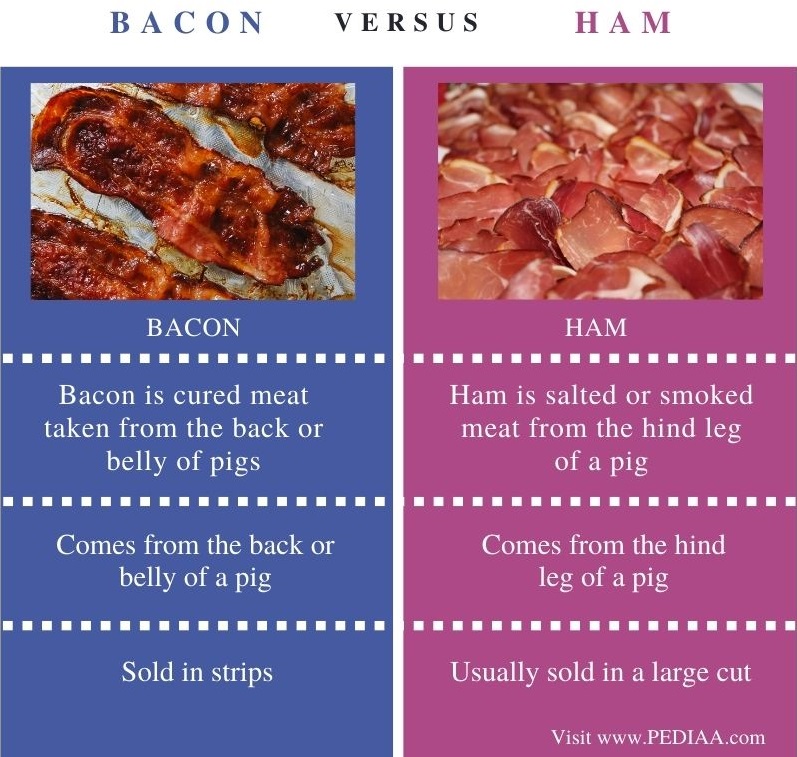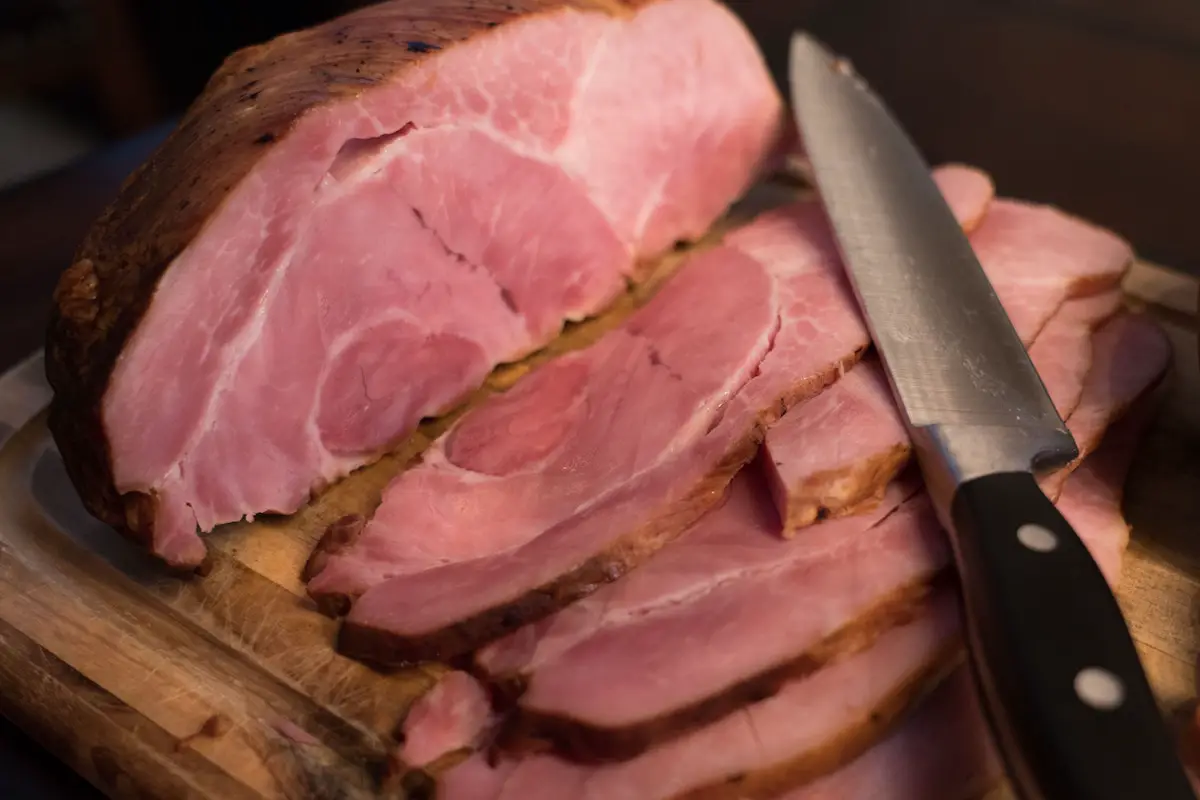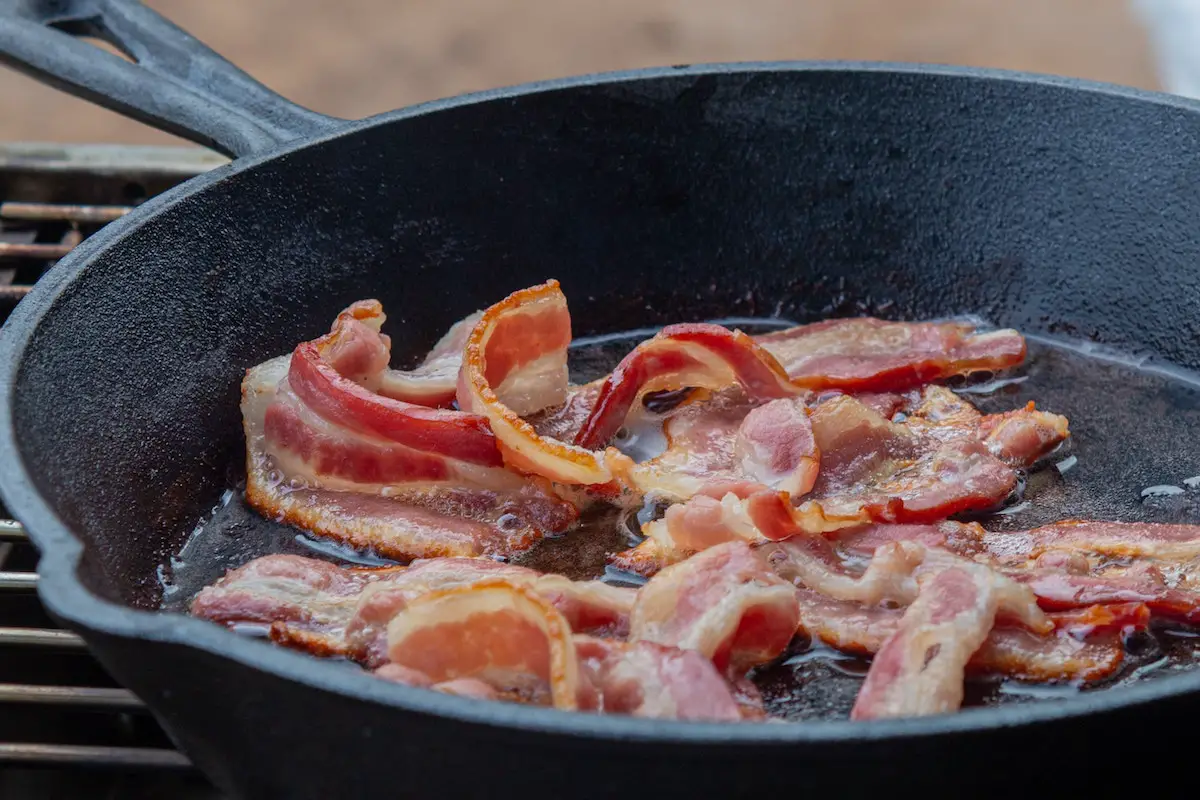Ham and bacon both are pork meats, but they are cut from different parts of the pig. Bacon can come from different parts of the pig, like the back, belly, or sides. Ham is usually cut from the back leg.
If you’re a meat lover, you’ve probably heard of ham and bacon. People often use these two pork products interchangeably, but they taste, feel, and are made in very different ways.
If you know the difference between ham and bacon, you can pick the right one for your recipe or meal.
Ham and bacon are two of the most popular cured pork products found in kitchens and restaurants globally. But what exactly sets these tasty meats apart? In this guide, we’ll explore how ham and bacon differ in their cuts of meat, curing methods, nutrition profiles, flavors, and best uses.
Overview of Ham and Bacon
First, a quick definition of each
-
Ham – Ham is meat from the hind leg of a pig. It’s taken from the thigh or rump sections Ham can be sold raw but is most often cured, smoked, or pre-cooked.
-
Bacon – Bacon comes from the sides, belly, or back of a pig. It is cured, smoked, and sold in strips or slices.
So in short, the main difference is that ham is from the rear leg and bacon is from the belly or back. But there are more in-depth distinctions when it comes to processing methods, nutrition, and taste as well.
Cuts of Meat for Ham and Bacon
Let’s start with the specific cuts used:
-
Ham cuts – Ham is cut from the thigh or rump of the pig. These areas contain larger muscles with less fat compared to other areas. Ham is sold as a whole, bone-in leg or as smaller boneless cuts like ham steaks or roasts.
-
Bacon cuts – The belly is the most common source of bacon. It contains streaks of fat running through the lean meat, which creates the signature look of bacon slices. Other bacon cuts include back bacon (from the pork loin) and jowl bacon (from the cheeks).
Curing and Processing Methods
In addition to different cuts, ham and bacon go through distinct curing and processing methods:
-
Ham curing – Ham is cured with salt, sugar, and other seasonings. It can be dry cured by rubbing the mixture into the meat or wet cured by soaking in brine. Smoking is optional. Ham is then cooked to various degrees.
-
Bacon curing – Bacon is cured by soaking in salty brine or using a dry rub. It’s heavily smoked over various wood types to add robust flavor. Cold air drying may be used too. Bacon is only partially cooked.
Nutrition Profiles
The nutrition profiles of ham and bacon also differ quite a bit:
-
Ham nutrition – A 3-ounce serving of baked ham contains around 150 calories, 4g fat, and 750mg sodium. It has high-quality protein, vitamins B1 and B6, niacin, phosphorus, and selenium.
-
Bacon nutrition – A slice of pan-fried bacon has 40 calories, 3g fat, and 170mg sodium. It contains protein, zinc, potassium, vitamins B2 and B12. However, most fat is unhealthy saturated and trans fat.
Flavor Profiles
When it comes to taste, each cured pork product has distinctive flavors:
-
Ham flavor – The flavor of ham has subtle salty and sweet notes from the curing process. It offers an umami, porky flavor from the high protein leg muscles. Any smokiness is mild.
-
Bacon flavor – Bacon features deep, smoky, robust flavors from hardwood smoking. It has very savory, salty, and subtly sweet tastes. The fat lends pleasant richness.
Best Uses
The differing flavors mean ham and bacon each shine in certain dishes:
-
Cooking with ham – Ham excels in sandwiches, omelets, baked entrees, soups, salads, and glazed with sauces. Whole baked hams are popular for holidays.
-
Cooking with bacon – Bacon is great in breakfast dishes, burgers, pizza, sandwiches, savory pies, salad toppings, and for flavoring vegetables. It’s often used in small, crumbled amounts.
Cost Differences
Bacon is generally more expensive per pound compared to ham. Factors like artisanal curing methods, smoker fuel costs, and popularity cause bacon to have a higher price tag. Less expensive cuts like ham hocks even out the differences when cooking in quantity.
Is One Healthier?
Ham and bacon are both high in sodium and considered processed meats. However, ham provides more protein, vitamins, and minerals overall. While neither are health foods, smaller portions of ham can more easily fit into a healthy diet compared to bacon.
-
Ham comes from the back leg and bacon from the belly/back.
-
Ham uses sugar in curing and light smoking. Bacon relies on heavy smoking.
-
Ham offers more nutrition while bacon has more fat and sodium.
-
Ham has delicate porky flavor. Bacon is smoky and rich.
-
Ham fits well in many dishes. Bacon is best used as a flavoring.
Understanding these contrasts between ham and bacon allows you to select the right one for your cooking needs. Now get sizzling up some ham or bacon and enjoy the unique flavors of these amazing cured meats.

Can you reuse bacon grease?
Yes, you can reuse bacon grease as cooking oil, as long as it has been properly stored and not contaminated with food particles or bacteria. It’s best to strain the grease through a fine mesh strainer or cheesecloth and store it in an airtight container in the refrigerator or freezer to make the bacon grease last longer. Reused bacon grease may have a slightly smoky flavor and can be used in cooking or baking for added flavor.
Ham Vs Bacon: What’s The Difference?
Ham and bacon are both popular pork meats that are often used in a variety of dishes.
In a lot of ways, they are the same, but there are also some important differences that make them different.
This part will talk about how ham and bacon are different in terms of taste, texture, and how they are cooked.
Ham and bacon have distinct flavors that are a result of their different preparation methods.
Ham is typically less salty and has a milder flavor than bacon. It has a slightly sweet taste and is often used in sandwiches or as a main dish.
Bacon, on the other hand, is known for its salty and smoky flavor. It is often used as a breakfast food or added to dishes for a burst of flavor.
Besides American bacon, there are other kinds of bacon that taste very different, like Irish bacon.
The texture of ham and bacon is also different. Ham is typically softer and less chewy than bacon.
It has a smoother texture and is often sliced thin. Bacon, on the other hand, is crispy and crunchy.
It’s chewy and is usually served in strips or cut up and added to dishes to give them more texture.
Ham and bacon require different cooking methods. Ham can be cooked in a variety of ways, including baking, boiling, or grilling.
It’s often sliced thin for sandwiches or cubed to use in casseroles or soups. You can eat it fresh or cured.
Bacon is typically fried or baked until crispy. It is often served as a breakfast food or added to dishes for flavor and texture.
Overall, even though both ham and bacon are made from pork, they taste, feel, and are cooked in very different ways.
Ham is milder and softer, while bacon is salty, smoky, and crispy.
Both meats are versatile and can be used in a variety of dishes, depending on your preferences.
Ham is a type of meat that comes from the hind leg of a pig. It is a popular food item that can be found in many different forms and styles.
Ham can be eaten raw, but it is typically cooked before it is consumed.

There are many different types of ham available, each with its own unique flavor and texture. Some of the most popular types of ham include:
- This kind of ham comes from Italy and is usually aged for at least a year. It tastes salty and savory and feels soft and tender.
- Serrano Ham: This kind of ham is from Spain and always has been aged for at least 18 months. It tastes nutty and slightly sweet, and it’s firm and chewy.
- Cooked Ham: This kind of ham is done cooking and ready to eat. Thin slices of it are often put on sandwiches or salads or pizzas to make them taste better.
- Smoked Ham: This kind of ham is cured and then smoked to make it taste better. It can be eaten cold or heated up before serving.
Ham can be used in a variety of different recipes, including sandwiches, salads, and casseroles.
It is a versatile ingredient that can be enjoyed in many different ways.

If you are a meat lover, you must have heard of bacon. Bacon is a type of cured meat that comes from the back, belly, or loin of a pig.
It is a popular breakfast food and is used in many dishes for its unique flavor. Here is everything you need to know about bacon.
In the market, there are different kinds of bacon, and each one tastes and feels different.
Here are some of the most popular types of bacon:
- Back bacon is leaner than other types of bacon because it is made from the loin of the pig. It is popular in the UK and Canada.
- Streaky bacon is made from a pig’s belly and has more fat than back bacon. It is commonly used in the US.
- Pancetta: Pancetta is an Italian bacon made from rolled bacon that has been cured. It is often used in pasta dishes.
- Canadian bacon: Like back bacon, Canadian bacon is made from the loin of the pig. It is popular in Canada and the US.
- American bacon is more lean than Irish bacon, which comes from the back of the pig. It is commonly used in traditional Irish breakfast dishes.
- Canadian bacon is made from the belly and back of the pig, and English bacon is made from the same parts. It is popular in the UK.
The way bacon is cut can affect its taste and texture.
Here are some of the most common cuts of bacon:
| Cut | Description |
|---|---|
| Rashers | Thinly sliced bacon that is popular in the UK and Ireland. |
| American Bacon | Thickly sliced bacon that is popular in the US. |
Bacon is usually cured and smoked to give it its unique flavor, no matter what kind or cut it is.
The shape and taste of bacon can vary depending on the type, cut, and preparation method.
Know what bacon is and the different cuts and types that are out there. Pick the right bacon for your next meal.
When it comes to comparing ham and bacon, many people wonder which one is healthier.
Bacon and ham both have a lot of protein, but they also have a lot of fat and sodium.
Here’s a breakdown of the nutritional differences between the two:
| Ham (3 oz) | Bacon (3 oz) | |
|---|---|---|
| Calories | 136 | 369 |
| Protein | 19g | 23g |
| Fat | 5g | 30g |
| Sodium | 1,038mg | 1,149mg |
As you can see, bacon is significantly higher in calories, fat, and sodium than ham. Ham is a better source of protein per calorie than bacon.
However, bacon does contain slightly more protein per serving than ham.
That being said, it’s important to remember that both ham and bacon are processed meats, which have been linked to a higher risk of heart disease, cancer, and other health problems.
Choose leaner cuts of pork or other protein-rich foods like chicken or fish if you want to eat something healthier.
In conclusion, both ham and bacon can be part of a healthy diet in small amounts. However, ham is usually thought to be the better choice because it has fewer calories, fat, and sodium.
